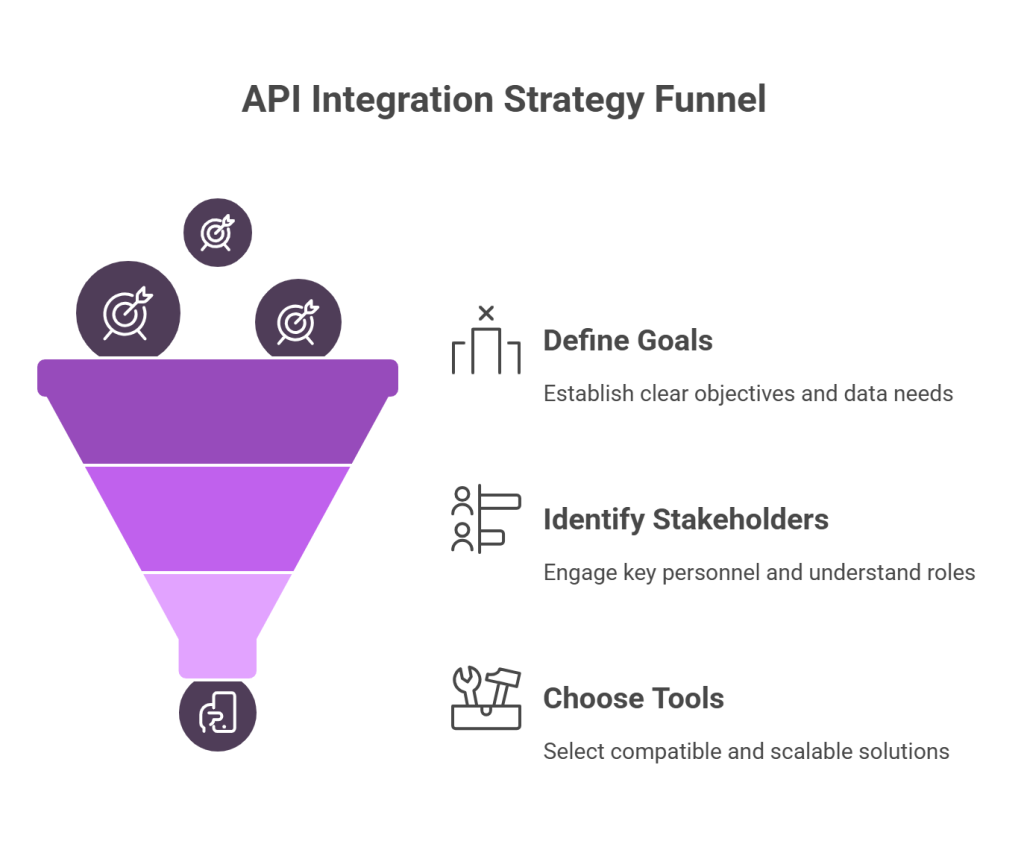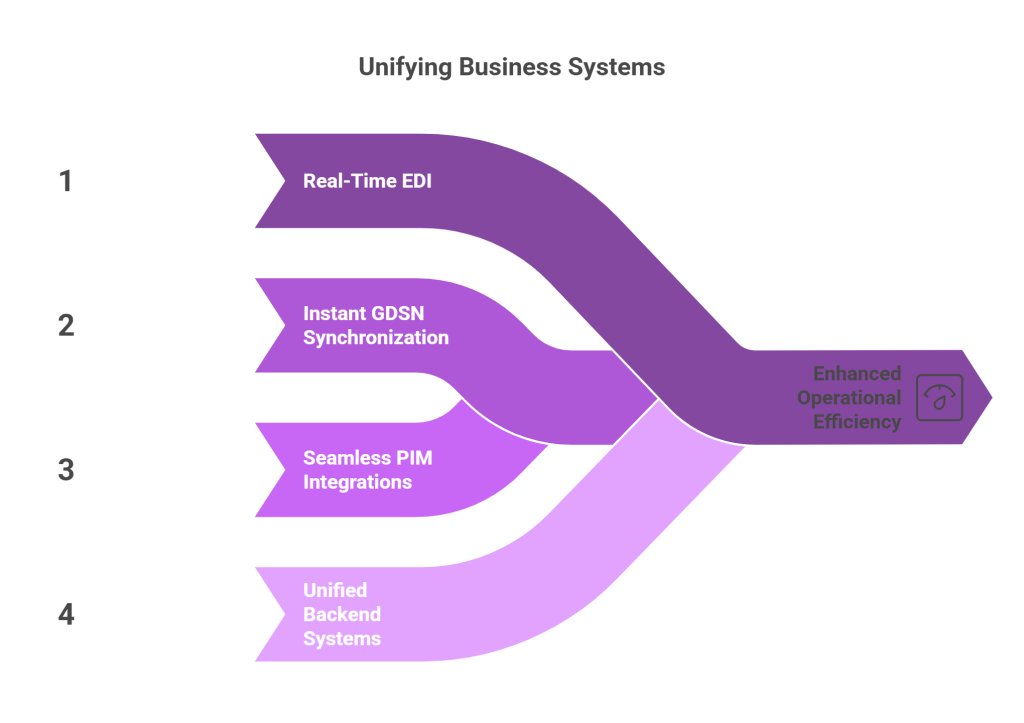Introduction
Did you know that companies integrating b2b API solutions have experienced a market capitalization increase exceeding 12% compared to those that haven’t? This significant advantage explains why over 90% of executives now consider APIs essential for their business missions. In today’s interconnected business landscape, b2b API integration simplifies and automates data exchange between business partners.
With more than 25 million APIs currently available in the digital ecosystem, choosing the right b2b integration tools can be overwhelming. However, the benefits are clear – reduced manual errors, enhanced data accuracy, and real-time access to critical business information. Additionally, businesses implementing a strong API integration strategy can respond faster to market changes, gaining a competitive edge while uncovering valuable insights into strategic decision-making.
We’ve created this guide to help you navigate the world of b2b integration without getting lost in technical jargon. Throughout this article, we’ll explore practical b2b integration examples, outline b2b API strategy fundamentals, and share b2b integration best practices that will help you transform how your company connects with partners and customers.
What is B2B API Integration?
An API (Application Programming Interface) is a set of protocols and tools that allow different software applications to communicate with each other.
In a B2B context, API integration represents the technology backbone that automates business processes and communication between two or more organizations. At its core, it’s about creating digital connections that allow companies to work and trade more effectively with customers, suppliers, and business partners through automated processes.
Key Benefits of APIs in B2B:
- Real-time data exchange
- Scalability and flexibility
- Reduced integration costs
- Improved data accuracy
- Faster onboarding of partners and suppliers
According to a Benchmark Report, companies using APIs report a 50% improvement in productivity and 59% faster innovation cycles.
How APIs Connect Business Systems
Application Programming Interfaces (APIs) serve as digital bridges between different software systems, enabling them to communicate seamlessly. These interfaces allow developers to integrate data, services, and capabilities from other applications without building them from scratch.
Instead of manually transferring information between systems, APIs create direct pathways for data to flow automatically. For instance, when a retailer’s inventory system needs to communicate with a supplier’s order fulfillment system, an API enables this conversation to happen instantly and accurately.
APIs function by collecting data from source applications, converting it into standardized formats, and sending documents to business partners using appropriate transport protocols. This automation eliminates time-consuming manual processes that are prone to errors and delays.
The Difference Between B2B APIs and Internal APIs
B2B APIs specifically facilitate connections between separate organizations, whereas internal APIs operate within a single company’s ecosystem. The key distinction lies in their purpose and scope:
- B2B APIs: Connect external partners, enabling real-time data exchange across company boundaries for supply chains and financial services
- Internal APIs: Integrate an organization’s applications and systems, improving internal workflows
Furthermore, B2B APIs often require additional security measures since they transmit sensitive information between different organizations. They typically support various data formats and systems, making them adaptable to diverse partner requirements.
Why B2B API Integration Matters for Business Leaders
For business leaders, B2B API integration delivers compelling strategic advantages beyond technical efficiencies. Recognizing the power of APIs, business departments now see the value of synchronous, real-time communication with partners.
B2B API integration enables organizations to unlock previously isolated data, extending reach to thousands of new customers who can connect with the company in more personal, meaningful ways. This capability transforms how businesses operate by replacing slow, inefficient, and error-prone manual processes that become unsustainable in a digitally connected world.
Essentially, B2B API integration offers flexibility, allowing companies to forge connections with new business partners and deliver new services to existing markets. This flexibility also enables businesses to access new markets, boosting returns and driving digital transformation.
The real-time processing capabilities make B2B API integration particularly valuable for supply chain processes. Rather than waiting overnight for updated shipping information, business departments can receive immediate updates, making faster and more informed decisions.
Planning Your API Integration Strategy

Successful b2b API integration begins with thorough planning that aligns with your business objectives. Comprehensive planning maximizes benefits, delivers tangible results, and can even help streamline integration costs. Let’s explore the critical steps in developing an effective API integration strategy.
1. Define Your Business Goals and Data Needs
The cornerstone of any b2b API strategy starts with examining your specific business requirements and aims. Begin by identifying the challenges you want to solve and the benefits you expect to gain. Subsequently, determine which processes need automation, what data must be exchanged, and your anticipated outcomes regarding efficiency improvements.
An effective API strategy consists of three essential elements: a set of goals, a clear rationale, and a concrete plan for turning those goals into reality. Your objectives might include:
- Building a composable enterprise
- Renovating legacy system landscapes
- Improving collaboration with partners
- Creating digital products or ecosystems
Importantly, your integration strategy should be documented to ensure all stakeholders share the same understanding and vision. This documentation provides clarity and underscores the relationship between API success and your overall business success.
2. Identify Key Stakeholders and Systems
Engaging relevant stakeholders from both businesses is critical for successful b2b API integration. This typically includes IT teams, business analysts, project managers, and end-users who will interact with the integrated software. Notably, stakeholders provide valuable insights into functional requirements and potential obstacles.
When mapping stakeholders, recognize the different roles within the buying organization:
- Economic buyers (focused on ROI and financial aspects)
- Direct users (daily users of your product/service)
- Champions (internal advocates for your solution)
- Decision makers (those with purchasing authority)
Understanding these stakeholder archetypes and their motivations helps you craft effective communications and address their specific concerns throughout the integration process.
3. Choose the right B2B API integration tools
Selecting appropriate b2b API integration tools is crucial for your project’s success. Consider these key criteria:
- Compatibility with existing systems: Your integration software must work seamlessly with your current tech stack
- Flexibility and scalability: Look for solutions that adapt to evolving requirements and grow with your business
- Security – Ensure secure authentication and authorization
- Ease of use: The ideal solution should simplify processes, not complicate them
- Cost and ROI: Focus on long-term value rather than just upfront investment
- Handle Errors – Provide effective error handling with a smooth user experience and facilitate troubleshooting
- Customer Support – Track API performance and uptime, provide API logs, and audit activity
- Analytics – Tracking key API metrics like API call volume, latency, error rates, availability, and requests per minute.
- Future-ready features: Choose platforms that support emerging technologies like AI and machine learning
Popular b2b API integration tools include Commport EDI Integration Solutions and Commport Datapool Solutions, with built-in APIs and offering many custom APIs, each with different capabilities to transform data between formats and connect disparate systems.
How APIs Unify Data Between Different Systems

APIs are not just about point-to-point connections; they are about creating a connected data fabric that synchronizes processes and systems across the enterprise. Here’s how APIs bring together EDI, GDSN, PIM, ERP, and other systems into a single operational ecosystem:
1. Enhancing EDI With Real-Time APIs
Traditional EDI operates on batch-based communication. APIs augment EDI by offering:
- Real-time acknowledgment of transactions
- Live updates on order status or shipment
- Dynamic mapping between EDI documents and ERP data formats
Combined Impact: APIs allow businesses to retain their EDI standards while gaining real-time operational visibility and control, especially when integrated with ERP or accounting systems.
2. Powering GDSN for Instant Product Data Synchronization
GDSN relies on structured and synchronized product data. APIs:
- Push product updates from PIM to GDSN in real-time
- Ensure compliance with GS1 standards automatically
- Reduce latency in synchronizing with retail partners
Combined Impact: APIs ensure that the same accurate product data flows from ERP to PIM to GDSN and retail partners, maintaining consistency across the supply chain.
3. Driving Seamless PIM Integrations Across the Stack
PIM sits at the intersection of marketing, sales, and supply chain. API integrations allow:
- Automatic updates from ERP to PIM (price, SKU availability)
- Publishing enriched content from PIM to eCommerce, GDSN, and marketplaces
- Live syncing of product status or changes
Combined Impact: APIs enable a closed-loop cycle where data flows bi-directionally from ERP to PIM to marketplaces and back, ensuring continuity and timeliness.
4. Uniting ERP, TMS, WMS, and Accounting via APIs
The backend layer of any B2B operation includes ERP (orders, finance), TMS (transport), WMS (inventory), and accounting systems. APIs:
- Trigger events across systems (e.g., shipment dispatch updates inventory)
- Sync financials between ERP and accounting platforms
- Coordinate fulfillment data from WMS to ERP and CRM
Combined Impact: APIs orchestrate workflows between core systems, reducing manual intervention, improving SLAs, and enhancing cross-functional transparency.
Conclusion
The path to successful integration follows clear steps – defining precise business goals, engaging key stakeholders, selecting appropriate tools, implementing consistent design standards, and establishing robust security protocols. However, the journey doesn’t end after implementation. Regular monitoring, maintenance, and optimization ensure your API ecosystem continues delivering maximum value.
Remember that B2B API integration represents more than just a technical solution. Instead, it serves as a strategic business asset that transforms how your organization connects with partners and customers. Commport B2B Solutions With Modern APIs Connect Seamlessly with All Trading Partners and Backend Systems, providing the foundation you need to automate critical business processes.
Ultimately, the question isn’t whether your business should implement B2B API integration, but rather how quickly you can deploy this essential capability. Though the process requires thoughtful planning and execution, the potential returns – from operational efficiency to market agility – make it an investment worth prioritizing. Your competitors certainly will.
Download: EDI Buyers Guide
Unlock the full potential of your supply chain with our comprehensive EDI Buyer's Guide — your first step towards seamless, efficient, and error-free transactions
Commport B2B Solutions
Download: GDSN Buyers Guide
Empower your business with global data synchronization; download our GDSN Buyer's Guide today and take the first step towards streamlined, accurate, and compliant product data management.
Frequently Asked Questions
B2B API integration offers several key advantages, including reduced manual errors, enhanced data accuracy, real-time access to critical business information, faster response to market changes, and valuable insights for strategic decision-making. It also enables companies to automate processes and improve communication with partners and customers.
B2B APIs facilitate connections between separate organizations, enabling real-time data exchange across company boundaries. In contrast, internal APIs integrate an organization’s own applications and systems to improve internal workflows. B2B APIs often require additional security measures and support various data formats to accommodate diverse partner requirements.
When planning a B2B API integration strategy, it’s important to define clear business goals and data needs, identify key stakeholders and systems involved, and choose the right integration tools. Consider factors such as compatibility with existing systems, scalability, ease of use, cost and ROI, and support for future technologies.
Key best practices include using consistent API design standards, ensuring secure authentication and authorization, testing integrations in a sandbox environment before deployment, and implementing robust error handling. It’s also crucial to maintain clear documentation and follow standardized protocols for seamless integration.
To monitor and optimize B2B API integrations, businesses should track key performance metrics such as response time, error rates, and availability. Regular logging and auditing of API activity is essential for security and compliance. Additionally, updating and versioning APIs, along with using analytics to improve workflows, can help maintain and enhance the integration over time.





